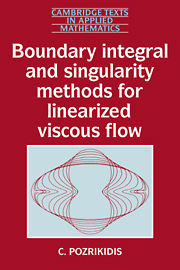4 - Generalized boundary integral methods
Published online by Cambridge University Press: 13 February 2010
Summary
The boundary integral equation discussed in section 2.3, provides us with a representation of a flow in terms of a dual distribution of a Green's function G and its associated stress tensor T; the two individual distributions are called the single-layer potential and the double-layer potential respectively. Odqvist (1930) noted that each of these potentials expresses an acceptable Stokes flow which, in principle, may be used independently to represent a given flow. This observation provides the basis for a new class of boundary integral methods called generalized or indirect boundary integral methods. In these methods, the flow is expressed simply in terms of a single-layer or a double-layer potential with an unknown density distribution. Imposing boundary conditions yields integral equations of the first or second kind for the densities of the distributions.
Odqvist (1930) studied the properties of the single-layer and double-layer potentials, and investigated the solutions of the integral equations that arise from generalized boundary integral representations. His work is discussed by Ladyzhenskaya (1969, Chapter 3) and Kim & Karrila (1991, Part 4, Chapter 15). In this chapter we summarize the main properties of the hydrodynamic potentials and then proceed to investigate the extent to which generalized boundary integral methods are capable of representing various types of internal and external flow.
It will be helpful to keep in mind throughout this chapter that boundary integral methods leading to integral equations of the second kind are highly preferable over those leading to integral equations of the first kind.
- Type
- Chapter
- Information
- Publisher: Cambridge University PressPrint publication year: 1992

